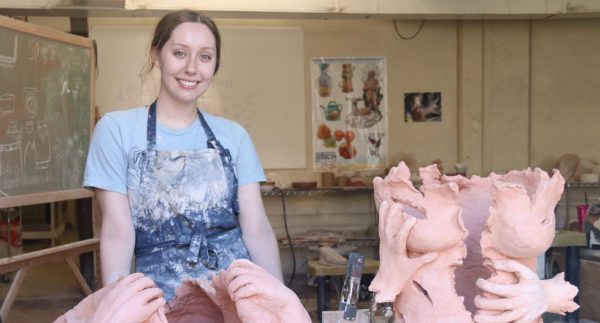Creating a message through body language
Erica Welter/The Lion’s Roar
Students make different expressions outside the campus Starbucks. Nonverbal communication can help define the tone of a person’s verbal message. This can include facial expressions, body posture and hand movements.
Whether it is tapping a foot or raising eyebrows, people display their thoughts and feelings from the top of their head down to their toes.
David Faucheux, instructor of management and business administration, explained the prevalence of body language.
“Since the beginning of time, humans have always used a mix of the spoken word and nonverbal signals to communicate,” said Faucheux. “90-95% of all communication is nonverbal through body language and tone of voice.”
Psychology Today notes that nonverbal communication can be expressed through movements, facial expressions, and vocal tone and volume. Microexpressions, brief displays of emotion which an individual tries to conceal, can register in a viewer’s mind even when they are not consciously aware of them.
In the article “The Ultimate Guide to Body Language,” Dr. Susan Krauss Whitbourne, professor emerita of psychological and brain sciences at the University of Massachusetts Amherst, said people spend their lives learning how to understand nonverbal cues.
“While we’re busy trying to decode their messages, they are also trying to decode ours,” stated Whitbourne. “There are times when you want other people to know exactly how you’re feeling, especially when those feelings are both positive and reciprocated. This isn’t always easy to do, especially if you’re not a particularly emotive type of person. At other times, however, you definitely want to hide your inner feelings.”
According to Faucheux, inconsistencies between what a person says and what their body language shows might indicate insincerity.
“If the nonverbal signals does not match the spoken word, humans will get an intuition, a hunch, that something is not right, but when they do match, the person comes across as more trustworthy, genuine, sincere and caring,” shared Faucheux.
Jerry Parker, instructor of world languages and cultures, described how nonverbal cues can be used to understand a person’s reactions.
“Open body language means he or she is happy or at ease,” said Parker. “Closed body language means he or she is uncomfortable.”
Parker noted that accurately interpreting body language can be tricky.
“Sometimes we mistake negative body language a lot when in reality the student is fully engaged and interested and he or she just has on his or her ‘thinking’ face,” explained Parker.
Before he became a teacher, Faucheux worked in advertising and marketing for 25 years. He found understanding body language was essential to his work.
“While understanding sales strategies and systems are important, understanding body language was one of the keys to my successful sales career,” shared Faucheux. “I have learned dozens of sales strategies on presenting products and services, how to overcome objections, closing the sale, but it was my knowledge and awareness of body language that took me to the next level.”
Body language offers clues into what someone thinks and feels, but it can also impact how people think.
Dr. Amy Cuddy, a social psychologist, researched nonverbal behavior. She found a correlation between how a person poses and the levels of testosterone and cortisol in their body. In her 2012 TED Talk “Your Body Language May Shape Who You Are,” Cuddy argued a person can boost feelings of confidence and perhaps impact their level of success by adopting a “power pose” for two minutes.
“Two minutes lead to these hormonal changes that configure your brain to basically be either assertive, confident and comfortable, or really stress-reactive, and feeling sort of shut down,” said Cuddy. “So, it seems that our non-verbals do govern how we think and feel about ourselves, so it’s not just others, but it’s also ourselves.”
Body language can be the gateway to understanding people’s personality and can be useful to excel in the professional workplace.
Your donation will support The Lion's Roar student journalists at Southeastern Louisiana University.
In addition, your contribution will allow us to cover our annual website hosting costs.
No gift is too small.








Upshift You • Jun 14, 2023 at 3:27 am
Great article! the Ted talk you refer too is amazing!